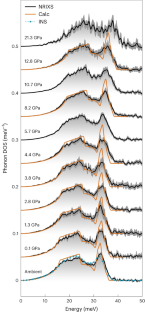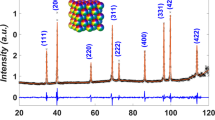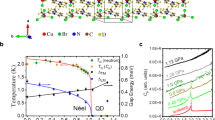Abstract
The anomalously low thermal expansion of Fe–Ni Invar has long been associated with magnetism, but to date, the microscopic underpinnings of the Invar behaviour have eluded both theory and experiment. Here we present nuclear resonant X-ray scattering measurements of the phonon and magnetic entropies under pressure. By applying a thermodynamic Maxwell relation to these data, we obtain the separate phonon and magnetic contributions to thermal expansion. We find that the Invar behaviour stems from a competition between phonons and spins. In particular, the phonon contribution to thermal expansion cancels the magnetic contribution over the 0–3 GPa pressure range of Invar behaviour. At pressures above 3 GPa, the cancellation is lost, but our analysis reproduces the positive thermal expansion measured separately by synchrotron X-ray diffractometry. Ab initio calculations informed by experimental data show that spin–phonon interactions improve the accuracy of this cancellation over the range of Invar behaviour. Spin–phonon interactions also explain how different phonon modes have different energy shifts with pressure.
This is a preview of subscription content, access via your institution
Access options
Access Nature and 54 other Nature Portfolio journals
Get Nature+, our best-value online-access subscription
$29.99 / 30 days
cancel any time
Subscribe to this journal
Receive 12 print issues and online access
$209.00 per year
only $17.42 per issue
Buy this article
- Purchase on Springer Link
- Instant access to full article PDF
Prices may be subject to local taxes which are calculated during checkout






Similar content being viewed by others
Data availability
All relevant data from experiments and calculations are available via Zenodo at https://doi.org/10.5281/zenodo.7987363.
Code availability
The computer code used to generate the numerical results is based on the Vienna ab initio simulation package and TDEP, both of which are publicly available. The formulations and algorithms necessary to reproduce the theory results of this study are described in the Methods section and ref. 27.
References
Wasserman, E. F. Invar: moment-volume instabilities in transition metals and alloys. in Handbook of Ferromagnetic Materials Vol. 5, 237–322 (Elsevier, 1990).
Guillaume, C. E. Recherches sur les aciers au nickel. Dilatations aux temperatures elevees; resistance electrique. C. R. Acad. Sci. 125, 235–238 (1897).
Guillame, C. E. Nobel Lecture in Physics https://www.nobelprize.org/uploads/2018/06/guillaume-lecture.pdf (1920).
Kübler, J. Magnetic moments of ferromagnetic and antiferromagnetic bcc and fcc iron. Phys. Lett. A 81, 81–83 (1981).
Pinski, F. J., Staunton, J., Gyorffy, B. L., Johnson, D. D. & Stocks, G. M. Ferromagnetism versus antiferromagnetism in face-centered-cubic iron. Phys. Rev. Lett. 56, 2096 (1986).
Keune, W. et al. Magneto-volume effects in γ-Fe ultrathin films and small particles. Phys. B 161, 269–275 (1989).
Weiss, R. J. The origin of the ‘Invar’ effect. Proc. Phys. Soc. 82, 281 (1963).
Moruzzi, V. L., Marcus, P. M., Schwarz, K. & Mohn, P. Ferromagnetic phases of bcc and fcc Fe, Co, and Ni. Phys. Rev. B 34, 1784 (1986).
Entel, P., Hoffmann, E., Mohn, P., Schwarz, K. & Moruzzi, V. L. First-principles calculations of the instability leading to the Invar effect. Phys. Rev. B 47, 8706 (1993).
Schröter, M. et al. First-principles investigations of atomic disorder effects on magnetic and structural instabilities in transition-metal alloys. Phys. Rev. B 52, 188 (1995).
van Schilfgaarde, M., Abrikosov, I. A. & Johansson, B. Origin of the Invar effect in iron-nickel alloys. Nature 400, 46–49 (1999).
Ehn, A., Alling, B. & Abrikosov, I. A. First-principles theory of the pressure-induced invar effect in FeNi alloys. Phys. Rev. B 107, 104422 (2023).
Abrikosov, I. A. et al. Competition between magnetic structures in the Fe rich fcc FeNi alloys. Phys. Rev. B 76, 014434 (2007).
Ruban, A. V. First-principles modeling of the Invar effect in Fe0.65Ni0.35 by the spin-wave method. Phys. Rev. B 95, 174432 (2017).
Wassermann, E. F., Acet, M., Entel, P. & Pepperhoff, W. Basic understanding of the relations between Invar, anti-Invar and martensite in Fe-based alloys. J. Magn. Soc. Jpn 23, 385–390 (1999).
Crisan, V. et al. Magnetochemical origin for Invar anomalies in iron-nickel alloys. Phys. Rev. B 66, 014416 (2002).
Dubrovinsky, L. et al. Pressure-induced Invar effect in Fe-Ni alloys. Phys. Rev. Lett. 86, 4851 (2001).
Nataf, L., Decremps, F., Gauthier, M. & Canny, B. High-pressure structural study of Fe64Ni36 and Fe72Pt28 Invar alloys at low-temperature. Phys. Rev. B 74, 184422 (2006).
Kizaki, T. et al. A new theory of the Invar behavior considering the role of phonon. J. Magn. Magn. Mater. 140–144, 245–246 (1995).
Kim, D. S. et al. Nuclear quantum effect with pure anharmonicity and the anomalous thermal expansion of silicon. Proc. Natl Acad. Sci. USA 115, 1992–1997 (2018).
Adeagbo, W. A., Zayak, A. & Entel, P. First-principles study of lattice instabilities in ferromagnetic L12 Fe3Ni: direct force constants method versus linear response. Ph. Transit. 79, 853–861 (2006).
Ikeda, Y., Körmann, F., Dutta, B., Carreras, A., Seko, A., Neugebauer, J. & Tanaka, I. Temperature-dependent phonon spectra of magnetic random solid solutions. npj Comput. Mater. 4, 7 (2018).
Gruner, M. E., Adeagbo, W. A., Zayak, A. T., Hucht, A. & Entel, P. Lattice dynamics and structural stability of ordered Fe3 Ni, Fe3Pd and Fe3Pt alloys using density functional theory. Phys. Rev. B 81, 064109 (2010).
Endoh, Y. Lattice dynamics in ferromagnetic invar alloys. J. Magn. Magn. Mater. 10, 177–182 (1979).
Maliszewski, E. & Bednarski, S. Lattice dynamics of Fe0.65Ni0.35 classical Invar. Phys. Stat. Sol. (B) 211, 621–629 (1999).
Heine, M., Hellman, O. & Broido, D. Effect of thermal lattice and magnetic disorder on phonons in bcc Fe: a first-principles study. Phys. Rev. B 100, 104304 (2019).
Heine, M., Hellman, O. & Broido, D. Theory of thermal properties of magnetic materials with unknown entropy. Phys. Rev. Mater. 6, 113805 (2022).
Sturhahn, W. CONUSS and PHOENIX: evaluation of nuclear resonant scattering data. Hyperfine Interact. 125, 149–172 (2000).
Chumakov, A. I. & Sturhahn, W. Experimental aspects of inelastic nuclear resonance scattering. Hyperfine Interact. 123, 781–808 (1999).
Hellman, O., Abrikosov, I. A. & Simak, S. I. Lattice dynamics of anharmonic solids from first principles. Phys. Rev. B 84, 180301(R) (2011).
Hellman, O., Abrikosov, I. A. & Simak, S. I. Temperature dependent effective potential method for accurate free energy calculations of solids. Phys. Rev. B 87, 104111 (2013).
Fultz, B. Phase Transitions in Materials 2nd edn (Cambridge Univ. Press, 2020).
Kobeissi, M. A. Mössbauer study of static and dynamic critical behavior in Fe. Phys. Rev. B 24, 2380 (1981).
Matsumoto, K. et al. Noncollinear spin structure in Fe-Ni Invar alloy probed by magnetic EXAFS at high pressure. J. Phys. Soc. Jpn 80, 023709 (2011).
Rhiger, D. Mössbauer Experiments in Iron-Nickel Alloys at High Pressures. PhD dissertation in Physics, Univ. Washington (1972).
Lohaus, S. H. et al. Thermodynamic stability and contributions to the Gibbs free energy of nanocrystalline Ni3Fe. Phys. Rev. Mater. 4, 086002 (2020).
Hayashi, K. & Mori, N. Effects of pressure on magnetization of Fe-Ni and Fe-Pt invar alloys. Solid State Commun. 38, 1057 (1981).
Rueff, J. P. et al. Magnetism of Invar alloys under pressure examined by inelastic X-ray scattering. Phys. Rev. B 63, 132409 (2001).
Kamarád, J., Míšek, M. & Arnold, Z. Direct measurement of magnetization isotherms of Fe64Ni36 Invar alloy in a diamond anvil cell. High Press. Res. 34, 365–370 (2014).
Hrubiak, R., Sinogeikin, S., Rod, E. & Shen, G. The laser micro-machining system for diamond anvil cell experiments and general precision machining applications at the High Pressure Collaborative Access Team. Rev. Sci. Instrum. 86, 072202 (2015).
Sturhahn, W. Nuclear resonant spectroscopy. J. Phys. Condens. Matter 16, S497 (2004).
Arnold, O. et al. Mantid—data analysis and visualization package for neutron scattering and μ SR experiments. Nucl. Instrum. Meth. Phys. Res. A: Accel. Spectrom. Detect. Assoc. Equip. 764, 156–166 (2014).
Lin, J. Y. Y., Islam, F. & Kresh, M. Multiphonon: phonon density of states tools for inelastic neutron scattering powder data. J. Open Source Softw. 3, 440 (2018).
Moriya, T. Spin Fluctuations in Itinerant Electron Magnetism (Springer, 1985).
Hubbard, J. The magnetism of iron. Phys. Rev. B 19, 2626 (1979).
Hasegawa, H. Single-site functional-integral approach to itinerant-electron ferromagnetism. J. Phys. Soc. Jpn 46, 1504–1514 (1979).
Hasegawa, H. Single-site spin fluctuation theory of itinerant-electron systems with narrow bands. J. Phys. Soc. Jpn 49, 178–188 (1980).
Zunger, A., Wei, S.-H., Ferreira, L. G. & Bernard, J. E. Special quasirandom structures. Phys. Rev. Lett. 65, 353 (1990).
Kresse, G. & Furthmüller, J. Efficiency of ab-initio total energy calculations for metals and semiconductors using a plane-wave basis set. Comput. Mater. Sci. 6, 15–50 (1996).
Kresse, G. & Joubert, D. Efficiency of ab-initio total energy calculations for metals and semiconductors using a plane-wave basis set. Phys. Rev. B 59, 1758 (1999).
Kresse, G. & Joubert, D. Efficient iterative schemes for ab initio total-energy calculations using a plane-wave basis set. Phys. Rev. B 54, 11169 (1996).
Kresse, G. & Hafner, J. Efficient iterative schemes for ab initio total-energy calculations using a plane-wave basis set. Phys. Rev. B 48, 13115 (1993).
Blöchl, P. E. Projector augmented-wave method. Phys. Rev. B 50, 17953 (1994).
Hobbs, D., Kresse, G. & Hafner, J. Fully unconstrained noncollinear magnetism within the projector augmented-wave method. Phys. Rev. B 62, 11556 (2000).
Perdew, J. P., Burke, K. & Ernzerhof, M. Generalized gradient approximation made simple. Phys. Rev. Lett. 77, 3865 (1996).
Acknowledgements
This work was supported by the National Science Foundation under grant no. 1904714 (S.H.L., P.G., C.M.B-C., C.N.S. and B.F.). Work at Boston College was supported by the US Department of Energy (DOE), Office of Science, Basic Energy Sciences, under award no. DE-SC0021071 (M.H. and D.B.). O.H. acknowledges support from the Swedish Research Council (VR) program 2020-04630. M.H. and D.B. acknowledge the Boston College Linux clusters for their computational resources and support. Calculations were also performed in part using MATLAB. This research used resources of the APS, a US DOE Office of Science User Facility operated for the DOE Office of Science by Argonne National Laboratory under contract no. DE-AC02-06CH11357 (S.H.L., P.G., C.M.B-C., G.S. and B.F.). HPCAT operations are supported by DOE-NNSA’s Office of Experimental Sciences. Use of the COMPRES-GSECARS gas-loading system was supported by COMPRES under NSF Cooperative Agreement EAR-1606856 and by GSECARS through NSF grant EAR-1634415 and DOE grant DE-FG02-94ER14466. This research also used resources at the Spallation Neutron Source, a DOE Office of Science User Facility operated by the Oak Ridge National Laboratory (S.H.L., C.M.B-C. and B.F.). We thank D. Rhiger for informing us of his dissertation research, C. Li for assistance with the pressure cells and J. A. Kornfield for use of the DSC. We also acknowledge the help from the beamline scientists at the APS (E. E. Alp, J. Zhao, B. Lavina and M. Hu) and D. Abernathy at Oak Ridge National Laboratory.
Author information
Authors and Affiliations
Contributions
S.H.L. designed and performed the experiments, analysed the data and compiled the paper. M.H. performed and analysed the calculations. P.G. and C.M.B-C. helped execute the beamline experiments at the APS. C.N.S. analysed the neutron scattering data. The remote XRD experiments were locally handled by G.S. O.H. developed and supervised the computational analyses. D.B. conceptualized and supervised the computational efforts. B.F. conceptualized and supervised the study. S.H.L., M.H., D.B. and B.F. wrote the paper, with contributions from all authors.
Corresponding authors
Ethics declarations
Competing interests
The authors declare no competing interests.
Peer review
Peer review information
Nature Physics thanks Ralf Roehlsberger, Jaime Fernandez-Baca and the other, anonymous, reviewer(s) for their contribution to the peer review of this work.
Additional information
Publisher’s note Springer Nature remains neutral with regard to jurisdictional claims in published maps and institutional affiliations.
Supplementary information
Supplementary Information
Supplementary Figs. 1–5 and discussion.
Rights and permissions
Springer Nature or its licensor (e.g. a society or other partner) holds exclusive rights to this article under a publishing agreement with the author(s) or other rightsholder(s); author self-archiving of the accepted manuscript version of this article is solely governed by the terms of such publishing agreement and applicable law.
About this article
Cite this article
Lohaus, S.H., Heine, M., Guzman, P. et al. A thermodynamic explanation of the Invar effect. Nat. Phys. 19, 1642–1648 (2023). https://doi.org/10.1038/s41567-023-02142-z
Received:
Accepted:
Published:
Issue Date:
DOI: https://doi.org/10.1038/s41567-023-02142-z
This article is cited by
-
An isotropic zero thermal expansion alloy with super-high toughness
Nature Communications (2024)
-
A delicate balance of phonons and spins
Nature Physics (2023)



